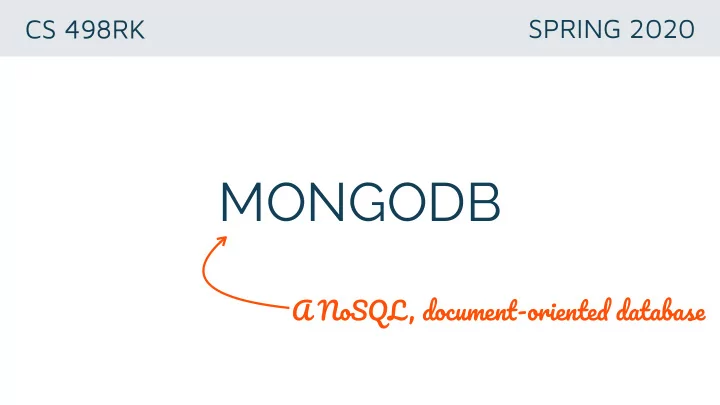

CS 498RK SPRING 2020 MONGODB A NoSQL , documen t -oriente d databas e
DATABASES organized collections of data
Databas e Model s
1960s NAVIGATIONAL linked list of free-form records hash on a primary key, linearly scan through a linked list en.wikipedia.org/wiki/Database
1970s RELATIONAL, SQL split data into a series of normalized tables use joins to combine data in di ff erent tables together en.wikipedia.org/wiki/Database
2000s NoSQL No t onl y Sq l fast key-value stores and document- oriented databases (JSON, XML) do not require fixed table schemas, no support for joins scale horizontally en.wikipedia.org/wiki/Database
Mong o
SQL Databases Tables Rows
MongoDB Databases Table s Collections Ro ws Documents
MONGO DOCUMENTS documents are JSON-like stored as BSON documents must be smaller than 16MB
Both of these documents can be stored in the same collection {"type":"llama", height:1.8} {"type":"camel", height:2.2, humps:2}
Wh y hav e separat e collection s ? Don’t want confused developers query e ff iciency data locality indexing (defined per collections)
Dat a Type s
BASIC TYPES JSON: null, boolean, number, string, array, and object MongoDB: null, boolean, number, string, array, date , regex , embedded document , object id , binary data , code
EMBEDDED DOCUMENTS { "type": "llama", "name": "Francesca", "height": 1.8, "farm": { "name": "Silver Lake", "owner": "Goldilocks" } }
OBJECTIDS Every document must have an "_id" key Every document in a collection must have a unique "_id" key ObjectId is the default type for "_id"
OBJECTIDS 0-3 4-6 7-8 9-11 Timestamp Machine PID Increment ~17M unique ObjectIds per process per second
Rea d Delet e CRUD Creat e Updat e
Creat e > llama = { "type": "llama", "name": "Francesca", "height": 1.8, "date" : new Date() } > db.camelids.insert(llama);
Rea d > db.camelids.findOne() { "_id" : ObjectId("54fda10dd452eebae749a0b8"), "type" : "llama", "name" : "Francesca", "height" : 1.8, "date" : ISODate("2015-03-09T13:32:43.737Z") }
Updat e > llama.diet = ["grass","hay"] > db.camelids.update({"type" : "llama"}, llama)
Updat e > db.camelids.findOne() { "_id" : ObjectId("54fda10dd452eebae749a0b8"), "type" : "llama", "name" : "Francesca", "height" : 1.8, "date" : ISODate("2015-03-09T13:32:43.737Z"), "diet" : [ "grass", "hay" ] }
Delet e > db.camelids.remove() > db.camelids.remove({type : “llama"}) > db.camelids.drop()
Updat e Modifie rs
Updat e > llama.diet = ["grass","hay"] > db.camelids.update({"type" : "llama"}, llama) > db.camelids.update({"type" : "llama"}, {"name": "maria"}) Wha t doe s thi s d o ?
Updat e > db.camelids.findOne() { "_id" : ObjectId("54fda10dd452eebae749a0b8"), "name" : "maria" }
Use update modifiers to update portions of a document > db.camelids.update({"type" : "llama"}, {"$set": {"name": “maria”}}) > db.camelids.findOne() { "_id" : ObjectId("54fda779d452eebae749a0ba"), "date" : ISODate("2015-03-09T14:00:22.530Z"), "height" : 1.8, "name" : "maria", "type" : "llama" }
Use update modifiers to update portions of a document > db.camelids.update({"type" : "llama"}, {"$inc": {"height": 0.2}}) > db.camelids.findOne() { "_id" : ObjectId("54fda779d452eebae749a0ba"), "date" : ISODate("2015-03-09T14:00:22.530Z"), "height" : 2, "name" : "maria", "type" : "llama" }
Arra y Modifie rs $push, $pop, $pull $each $sort, $slice $ne/$push, $addToSet/$each positional access
Querie s an d $-Conditional s
QUERYING IN MONGO find() & findOne() $-conditionals queries return db cursor that lazily returns batches of documents
Basi c Querie s > db.camelids.find() > db.camelids.find({"type" : "llama"}) > db.camelids.find({"type" : "llama","name" : "Francesca"}) { "_id" : ObjectId("54fda10dd452eebae749a0b8"), "type" : "llama", "name" : "Francesca", "height" : 1.8, "date" : ISODate("2015-03-09T13:32:43.737Z") }
Specif y whic h ke ys t o retur n Fro m > db.camelids.findOne({“type":"llama"}, {"_id":0,"name":1}) { "name" : "maria" } Wher e
$-Conditional s > db.camelids.findOne({"height":{"$lte" : 1.5, "$gte" : 1.2}}) > db.camelids.findOne({"type" : {"$in" : [“llama”,”alpaca"]}}) > db.camelids.find({"$or" : [{"type" : "alpaca"},{"name" : "Francesca"}])
Schem a Desig n
ONE-TO-FEW > db.person.findOne() { name: 'Kate Monster', ssn: '123-456-7890', addresses : [ { street: '123 Sesame St', city: 'Anytown', cc: 'USA' }, { street: '123 Avenue Q', city: 'New York', cc: 'USA' } ] embedded document } blog.mongodb.org/post/87200945828/6-rules-of-thumb-for-mongodb-schema-design-part-1
ONE-TO-MANY > db.parts.findOne() { _id : ObjectID('AAAA'), partno : '123-aff-456', name : '#4 grommet', qty: 94, cost: 0.94, price: 3.99 each part has own document } blog.mongodb.org/post/87200945828/6-rules-of-thumb-for-mongodb-schema-design-part-1
ONE-TO-MANY > db.products.findOne() { name : 'left-handed smoke shifter', manufacturer : 'Acme Corp', catalog_number: 1234, parts : [ ObjectID('AAAA'), ObjectID('F17C'), ObjectID('D2AA'), // etc array of references to part documents ] blog.mongodb.org/post/87200945828/6-rules-of-thumb-for-mongodb-schema-design-part-1
ONE-TO-MANY > product = db.products.findOne({catalog_number: 1234}); > product_parts = db.parts.find({_id: { $in : product.parts } } ).toArray() ; application-level join blog.mongodb.org/post/87200945828/6-rules-of-thumb-for-mongodb-schema-design-part-1
ONE-TO-GAZILLION > db.hosts.findOne() { _id : ObjectID('AAAB'), name : 'goofy.example.com', ipaddr : '127.66.66.66' } > db.logmsg.findOne() { time : ISODate("2014-03-28T09:42:41.382Z"), message : 'cpu is on fire!', host: ObjectID('AAAB') parent-referencing } blog.mongodb.org/post/87200945828/6-rules-of-thumb-for-mongodb-schema-design-part-1
ONE-TO-GAZILLION > host = db.hosts.findOne({ipaddr : '127.66.66.66'}); > last_5k_msg = db.logmsg.find({host: host._id}).sort({time : -1}).limit(5000).toArray() application-level join blog.mongodb.org/post/87200945828/6-rules-of-thumb-for-mongodb-schema-design-part-1
TWO-WAY REFERENCING db.person.findOne() { _id: ObjectID("AAF1"), name: "Kate Monster", tasks: [ ObjectID("ADF9"), ObjectID("AE02"), ObjectID("AE73") // etc array of references to task documents ] } blog.mongodb.org/post/87892923503/6-rules-of-thumb-for-mongodb-schema-design-part-2
TWO-WAY REFERENCING db.tasks.findOne() { _id: ObjectID("ADF9"), description: "Write lesson plan", due_date: ISODate("2014-04-01"), owner: ObjectID("AAF1") } reference to person document blog.mongodb.org/post/87892923503/6-rules-of-thumb-for-mongodb-schema-design-part-2
DENORMALIZING MANY-TO- ONE > db.products.findOne() { name : 'left-handed smoke shifter', manufacturer : 'Acme Corp', catalog_number: 1234, parts : [ { id : ObjectID('AAAA'), name : '#4 grommet' }, { id: ObjectID('F17C'), name : 'fan blade assembly' }, { id: ObjectID('D2AA'), name : 'power switch' }, // etc ] no join required to list part names } blog.mongodb.org/post/87892923503/6-rules-of-thumb-for-mongodb-schema-design-part-2
DENORMALIZING MANY-TO-ONE > product = db.products.findOne({catalog_number: 1234}); > part_ids = product.parts.map( function(doc) { return doc.id } ); a little more work to application-level join > product_parts = db.parts.find({_id: { $in : part_ids } } ).toArray() ; blog.mongodb.org/post/87892923503/6-rules-of-thumb-for-mongodb-schema-design-part-2
DENORMALIZING ONE-TO-MANY > db.parts.findOne() { _id : ObjectID('AAAA'), partno : '123-aff-456', name : '#4 grommet', product_name : 'left-handed smoke shifter’, product_catalog_number: 1234, qty: 94, cost: 0.94, price: 3.99 } blog.mongodb.org/post/87892923503/6-rules-of-thumb-for-mongodb-schema-design-part-2
Recommend
More recommend